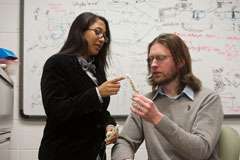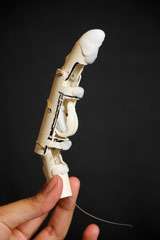Student researchers developing realistic prosthetic finger

We use our hands so often during the day, it's easy to take for granted just how complex our fingers are. Graduate students in the University of Hartford's prosthetics and orthotics program understand these complicated mechanics. Now one of them is using her knowledge to develop what she hopes will be the most realistic prosthetic finger on the market.
While observing patients' use of prosthetic hands, Casey Beasley M'15 noticed there was much room for improvement so she decided to create a new finger for her University Honors project. Under the guidance of Assistant Professor Michael Wininger from the University's College of Education, Nursing and Health Professions, Beasley spent last summer and fall developing 12 working prototypes. There are a few factors that make her design so unique.
The prototype, known as a biomimetic finger because it mimics the function and structure of a natural finger, includes a "fat pad simulant." Beasley says this pad "takes on a key characteristic of the natural human grasp: a sort of soft tissue compliance that aids our fingers in securely grasping many objects."
The other feature involves the phalangeal segments, or bones, of the finger. Beasley's creation uses continuously adjustable phalangeal segments so there is a more customized fit for the patient while still making it possible to mass-manufacture the fingers.

This spring, three of Beasley's classmates joined the project. They are Derek Becker M'15, Joseph Cassella M'15, and Stephen Sousa M'16. Each student brings their own perspective and expertise, and all are focused on expanding the finger design to a complete hand prototype. A Connecticut Space Grant Consortium Student Project Grant award of $932 will help with the next step, which is to send the best prototype out for machining and then develop the electronics to make it work.
Beasley says she was comfortable with science in high school, but also enjoyed art. When it came time to start thinking about college, she began looking for a way to combine her interests. "I looked at a lot of areas and one that stood out for me was prosthetics and orthotics. And when I started looking into schools, the University of Hartford became an obvious choice."
Provided by University of Hartford

















